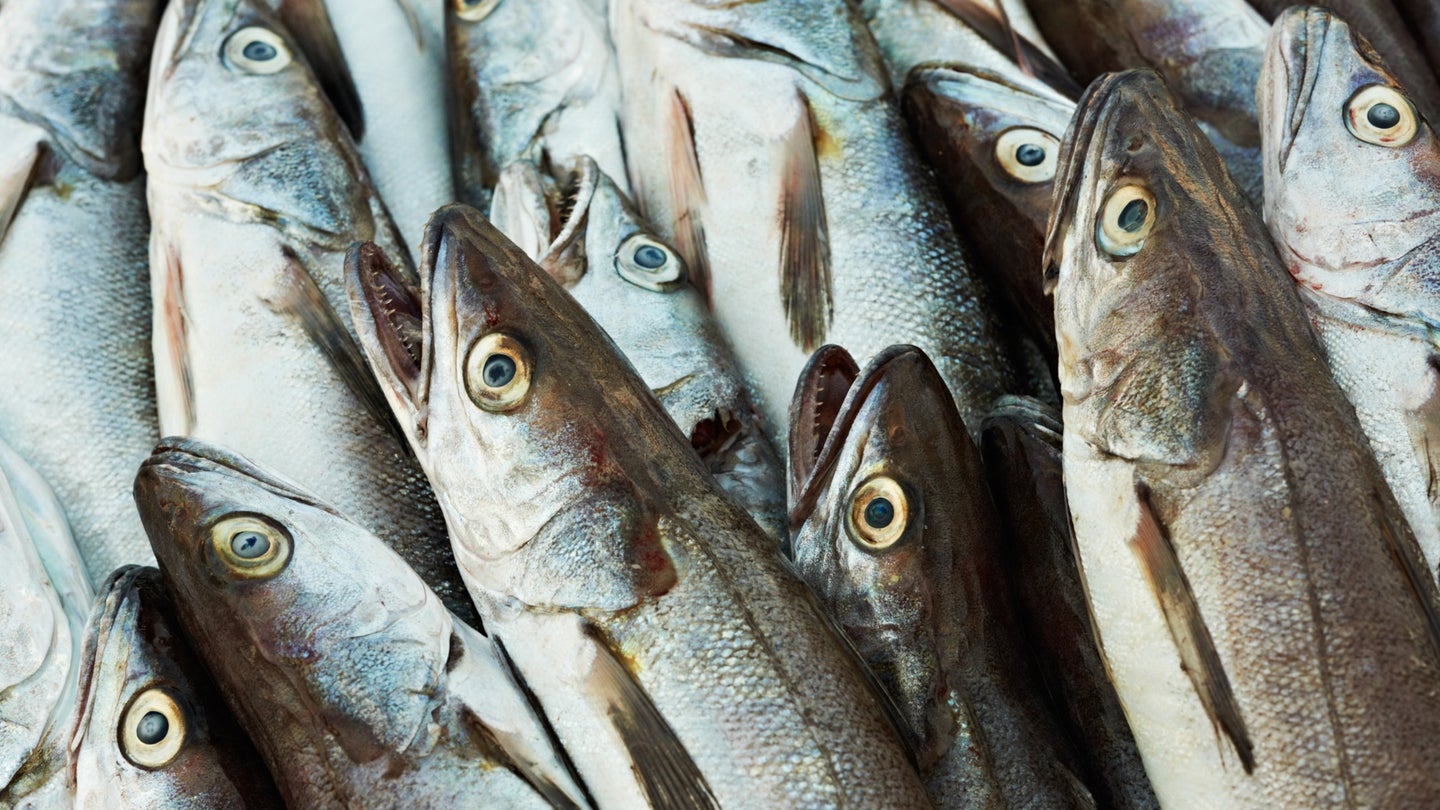No guts left behind: Iceland’s quest to repurpose fish waste
Cod heads, skin, blood. You name it, there’s an initiative to turn it into a high-value product and divert it from the trash.

This article was originally featured on Hakai Magazine, an online publication about science and society in coastal ecosystems. Read more stories like this at hakaimagazine.com.
A bleary-eyed predawn traveler walking through the arrivals hall of Iceland’s Keflavik Airport blinks at a sight that’s hard at first to register: an enormous advertisement showing a shirtless man holding an infant. The man’s torso and visible arm show a swath of pucker-patterned skin. He looks half-aquatic, like a member of some superhero universe.
As it happens, this sleep-deprived analysis isn’t far off. The baby-holding man, Pétur Oddsson, is a power station worker. In 2020, he endured a 60,000-volt electrical shock; it left almost half his body covered in deep thermal burns that charred layers of his skin off. Such deep and extensive burns can be fatal—skin damaged in this way can’t make new cells to regenerate, and infections can easily set in. But Oddsson’s life was spared by an ingenious invention: grafted cod skin—7,000 square centimeters of it. The procedure adorned Oddsson’s upper body with the permanent, distinct imprint of scales.
Oddsson’s cod skin grafts are a marvel of medical technology. But they also represent something else: the manifestation of an unusual and ambitious experiment in environmental efficiency. The skin grafts are just one of a slew of products—including Omega-3 capsules, cold virus pretreatment sprays, and dog snacks—made from what was once Iceland’s cod catch detritus. They come largely from the efforts of 100% Fish—a project spurred by the incubator Iceland Ocean Cluster in collaboration with research institutes and private companies to determine how to repurpose byproducts from the country’s US $2-billion seafood sector.
So far, enterprising Icelanders have unlocked uses for almost 95 percent of a cod—a pretty recent jump forward. In 2003, people only knew what to do with about 40 percent of the fish.
Árni Mathiesen, the cluster’s senior adviser and the country’s former fisheries minister, says the 100% Fish Project has created jobs and manifested once-scarce domestically produced goods. It has also, adds Alexandra Leeper, the cluster’s head of research and innovation, provided lower-impact fish meal for a burgeoning aquaculture industry. Relatedly, 100% Fish is looking beyond cod, too. A company called Nordic Fish Leather is upcycling farmed salmon skin into leather for accessories and another, Primex, is extracting chitosan from the shells of wild-caught Atlantic northern shrimp, which can be used as a blood-clotting agent.
The cod skin grafts are the brainchild of Fertram Sigurjonsson, a chemist and the founder of biotech company Kerecis, which is part of the 100% Fish Project. The grafts come in several sizes—wide strips, for large wounds; glove shapes, for hands; and granules, which act like putty in smaller wounds—and have been used to treat thousands of burn victims, diabetes patients with open wounds, and women with infected C-sections. Doctors can perform some of these procedures with pigskin grafts, but those are harvested from animals engineered for the purpose. The fish skin, conversely, comes from cod caught for human consumption by fishermen in Sigurjonsson’s northwestern hometown of Isafjordur. (Fishermen who also own valuable shares in his company.)
Sigurjonsson says Kerecis currently transforms a mere 0.01 percent of Icelandic cod skins into grafts. But as demand grows, and as Kerecis’ research and development department determines more uses—they’re investigating breast reconstruction—he’s looking to expand.
By weight, a cod is about eight percent skin. Beyond making for good grafting material, cod skin is rich in collagen, a supplement for human skin, ligament, and bone health. Cod skin easily sheds this protein when it’s boiled in water with enzymes, says Hrönn Margrét Magnúsdóttir. She’s the founder of a collagen supplement and energy drink company called Feel Iceland, which uses collagen derived from 700 tonnes of fish skin per year.
Bones account for at least 35 percent of a cod’s weight. Icelandic companies have long dried fish heads and spines with the country’s abundant geothermal energy and exported them to Nigeria, where they’re the base of a protein-rich soup. But Margrét Geirsdóttir, a project manager at Matís, a food and biotechnology research institute that partners with the Iceland Ocean Cluster, says the unpredictability of that market has sent researchers looking for new applications—such as extracting calcium for supplements.
By far the most challenging holdouts to whole-fish use are the blood and eyeballs, says Geirsdóttir.
According to Icelandic lore, squeezing the liquid from a redfish eyeball onto a wound prevents infection. Matís scientists followed this up, studying whether cod eyeballs might have antiseptic properties. No such luck. They also had a project, says Geirsdóttir, to see whether the eyes contained valuable fats. They do, she says, “but it’s such a low amount and you would need to [extract] it by hand, so it’s not paying off.”
Fish blood, accounting for 10 percent of a fish’s weight, might be used to make products like those made from the blood of land animals, such as sausage filler, fish feed, or fertilizer. Yet Geirsdóttir says the hardest part about working with fish blood is collecting it. On a commercial fishing boat, cod are quickly bled to maintain their freshness. Convincing skeptical fishermen to invest in storing the fish intact means proving the endeavor is worthwhile.
There is an optimistic precedent, however. Fishermen once tossed cod livers overboard; now they’re an expensive delicacy that fishermen are happy to preserve. What changed? Several years back, Geirsdóttir says, fishermen began to see high profits from the sale of cod liver. “Then they started to see the value in it,” she says.
This article first appeared in Hakai Magazine and is republished here with permission.